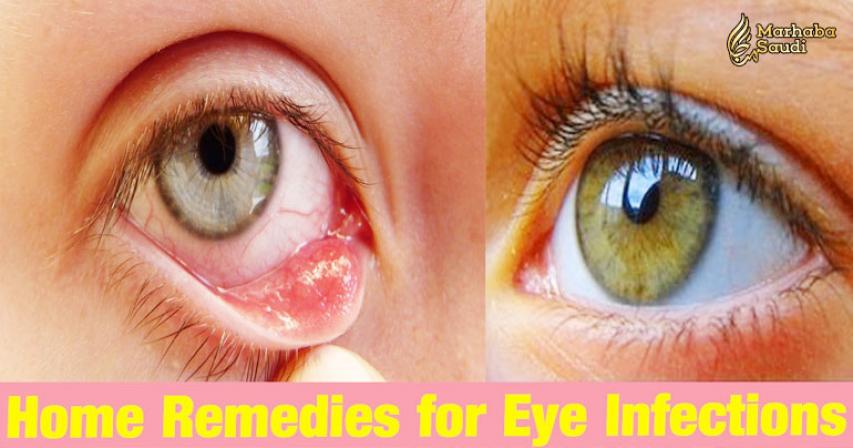11 Home Remedies To Treat Eye Infections Naturally

When organisms like bacteria or viruses infect your eyes, they can get red and swollen. What can you do about this? Treatment for an eye infection can vary depending on its cause. So here’s a look at some common eye infections and how you can deal with theaaaaaaam.
Conjunctivitis
Conjunctivitis or red eye is an eye infection involving inflammation and reddening of the mucous tissue that covers the front of the eye (the conjunctiva). You typically experience watering of the eyes and itchiness when you have this eye infection. Conjunctivitis can be caused by bacterial or viral infections. It can also be a result of an allergic reaction to, say, dust mites or pollen or your eye coming in touch with something that irritates it like chlorinated water or shampoo. If it’s caused by an allergic reaction, you might also get a sticky coating on your eyelashes.
Conjunctivitis usually clears up on its own in a couple of weeks. Your doctor might also prescribe antibiotic eye drops (in case it’s caused by an infection) or anti-allergy medication (if it’s caused by allergies). 1 But if you want to explore some natural remedies, here are some that have been found to be effective against conjunctivitis.
1. Honey
Applying honey might help when you have conjunctivitis caused by an infection. As one study showed, honey was found to reduce swelling, redness, pus discharge and the time in which bacterial infections cleared up. This was a result of its antibacterial properties2
2. Euphrasia
Euphrasia or eyebright can be applied to the eyes to treat conjunctivitis. A study that used euphrasia eye drops to treat conjunctivitis found that 81.5% participants recovered completely while 17.0% showed a clear improvement.3 Euphrasia has astringent and anti-inflammatory properties. Aucubin, a bioactive compound in it, is also known to have antibacterial properties. These characteristics of eyebright are thought to work cumulatively to help with conjunctivitis.
3. Ginkgo Biloba
This herb is used to treat a variety of conditions. And there is some evidence that it could help with conjunctivitis too. A study that looked at patients who were treated with eye drops of ginkgo biloba extracts and hyaluronic acid ophthalmic solution and hyaluronic acid ophthalmic solution alone for the treatment of seasonal allergic conjunctivitis found that those treated with ginkgo biloba showed significant improvements in symptoms like swelling, redness and conjunctival discharge while those treated with a hyaluronic acid solution alone only showed small improvements.5
4. Chamomile
Chamomile has a reputation as a soothing eyewash that helps with conjunctivitis. Chamomile has anti-inflammatory and antimicrobial properties which may account for its healing effects. Do check if you’re allergic to chamomile before using it as an eyewash though as some people are known to be sensitive to it. 6
Styes
Styes are small lumps on your eyelids that can be painful. You can also get a watery eye and experience a reddening of the eyelid or eye when you get a stye. Staphylococcus bacteria related eye infection usually trigger styes. These bacteria usually live on our skin without causing any trouble but can sometimes lead to infections. Styes usually get better on their own in about one to three weeks, especially after they burst and pus is released. But please don’t try to burst a stye yourself, it’s better to see a doctor if you have a really painful or swollen stye. Here are some things that you can do to get better if you have a stye:
1. Use A Warm Compress
Hold a cloth that has been dipped in warm water (take care that the water is not too hot) against the affected eye for five to ten minutes. After that massage the area gently. Do this three to four times a day till some pus is released or the stye clears up. The heat of the compress helps to release and drain pus which quickens healing. In fact, using warm compresses routinely can even prevent styes from forming.7
2. Try Baby Shampoo
You can also try gently wiping your eye with some cotton which has been soaked in baby shampoo. Remember to stick to baby shampoo which is alkaline like the surfaces of your eyes.8
3. Clove
Cloves are commonly used to treat styes. The beneficial effects of cloves may be due to its oils which contain a compound called eugenol that has antiseptic and pain relieving properties.9 Rub a clove with some water on a rough surface (traditionally a grindstone is used)and apply the paste on the stye. make sure that the paste doesn’t get into your eye though.10
4. Chamomile
As we saw earlier chamomile has anti-inflammatory and antimicrobial properties. So moistening a chamomile tea bag with warm water and fixing it over the stye can be helpful.11
Blepharitis
Blepharitis is a condition where the glands near your eyelids produce excess oil and your eyelids become inflamed at the edges. It can give you sore, reddish, itchy eyelids that stick together, greasy crusted eyelashes, loss or abnormal growth of eyelashes and an increased sensitivity to light. It can be due to a skin condition known as seborrheic dermatitis (dandruff) which causes oily, flaky skin or maybe a response to staphylococcus bacteria which is found on the skin of many people and usually doesn’t cause any harm. Generally, blepharitis is a chronic condition that can’t be cured and most people have repeated episodes. A severe case may warrant antibiotics. However, in other cases some home remedies can help:
1. Follow An Eyelid Cleaning Routine
Use a warm compress which will make oil from glands around the eye more fluid. Then massage your eyelids gently to remove oil from these glands and clean your eyelids to wipe off any extra oil, dirt, or bacteria. Do this once or twice daily as a routine.
2. Use Baby Shampoo
Loosen oily debris and crusts by placing a warm washcloth over your eyes for about five minutes. Then dilute three drops of baby shampoo with two to three ounces of warm water and use a clean washcloth to rub away loose crusts and scales at the edge of your eyelids. Finish up by washing your eyes with warm water and drying them. Do this in the morning and at night.13
3. Try Tea Tree Oil
According to a study scrubbing the eyelids with 10% tea tree oil can reduce mites that are found in people with blepharitis as well as eye discomfort. The researchers recommend that patients scrub their eyelids at least 5 times a week.
Infections Of The Cornea
Your cornea can get infected by fungi, viruses, bacteria, or parasite. Symptoms of an infection can include hazy vision, bloodshot eyes, itching, discharge from your eyes, sensitivity to light, pain, watery eyes, or white patches on the cornea. Your doctor will help you figure out the cause and treatment usually involves eye drops which can treat viruses like herpes, bacteria, fungi etc. Don’t delay going to the doctor as untreated infections can permanently scar your cornea and even affect vision.15
How To Prevent Eye Infections
Some general guidelines can help keep your eye healthy:
- Wash your hands before you touch your eyes.
- Don’t share eye makeup and change your kit every six months to lower chances of germs growing on it.
- If you wear contact lens, make sure they’re cleaned properly and don’t share equipment.
- If you have an eye infection, don’t use eye makeup or contacts till it clears up.
- Don’t expose your eyes to contaminated water.
- Avoid sharing pillows, towels, hankies, or washcloths.






Comments